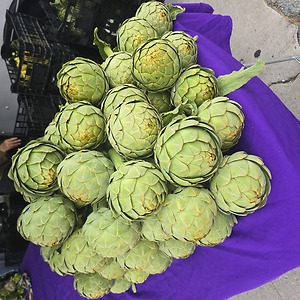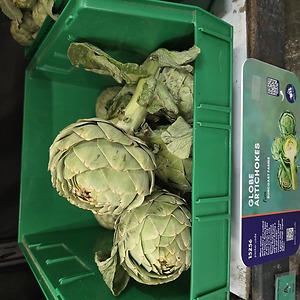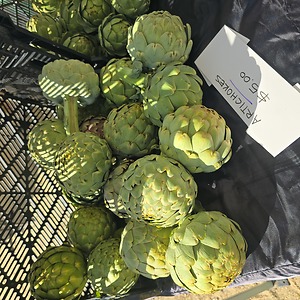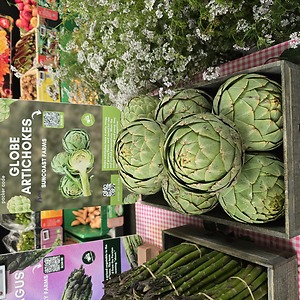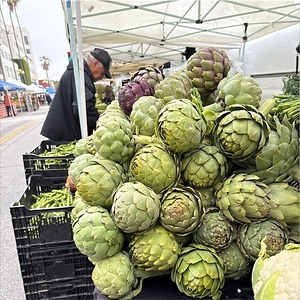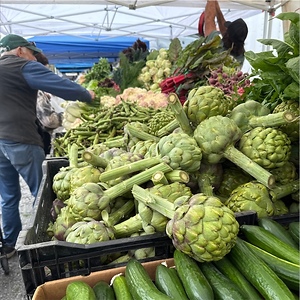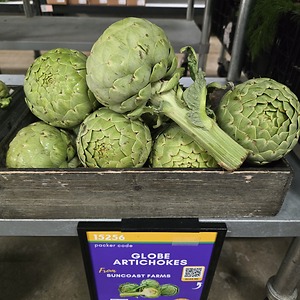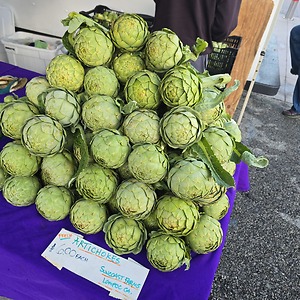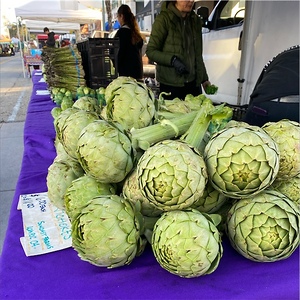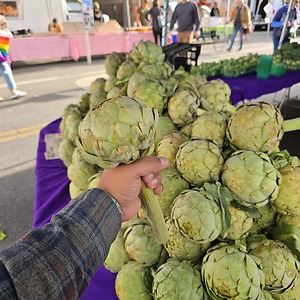

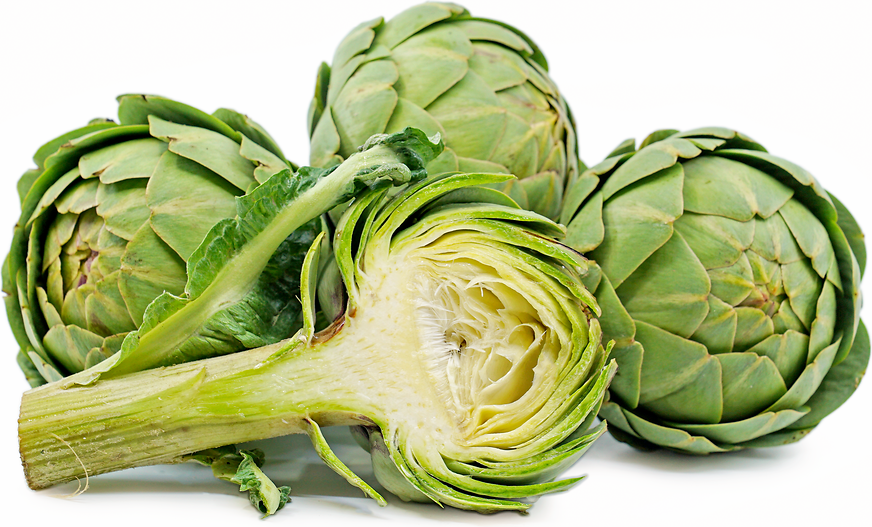
Globe Artichokes
Estimated Inventory, lb : 14.70
This item was last sold on : 07/31/25
Description/Taste
Globe artichokes vary in size from small to large, depending on the variety, and generally average 7 to 15 centimeters in diameter. The round, unopened flower bud is compact, comprised of tight layers of triangular, slightly pointed bracts. The thick, green bracts are fleshy, somewhat curved, and sharp with small spines on the tips. As each layer is peeled away, the color of the bracts transform from green to pale yellow or purple, and each bract grows smaller and smaller towards the interior, revealing a central heart surrounded by immature florets known as the choke. Globe artichokes should feel heavy for their size, and when the buds are gently squeezed, they should emit a sound referred to as a squeak. Young Globe artichokes can be consumed raw, but many artichokes are sold in more mature stages, requiring cooking. When mature artichokes are cooked, the lower, fleshy base of the bracts and the heart are the only portions consumed. These fleshy bracts and heart develop a soft and tender consistency and have a green, nutty, and slightly tangy, vegetal flavor.
Seasons/Availability
Globe artichokes are available year-round, with peak seasons in the spring and fall.
Current Facts
Globe artichokes, botanically classified as Cynara scolymus, are the immature flower heads of an herbaceous perennial belonging to the Asteraceae family. The unopened flower buds grow on a large plant comprised of thick stalks and leaves that reaches anywhere from 1 to 5 meters in height and is native to the Mediterranean. Each plant can produce 2 to 3 primary buds at the top of the erect stalks, with 8 to 10 smaller buds on the lower portions of the plant. Globe artichokes are also known as French artichokes and Green artichokes and are favored as a specialty ingredient utilized by chefs for their unusual appearance and savory, vegetal flavor. There are over 140 varieties of artichokes found worldwide, with approximately 40 varieties grown commercially. Globe artichokes are also popular home garden plants, often sold under varietal names such as Green Globe, Chianti, Mercury, Big Heart, King, and Siena. If the flower buds are left on the plant to bloom, they open into a brightly colored purple-blue flower that can reach over fifteen centimeters in diameter. These flowers are beneficial to home garden blooms, attracting pollinators, and are also used in floral bouquets to add color, texture, and visual interest.
Nutritional Value
Globe artichokes are a good source of potassium to balance fluid levels within the body and folate to promote the production of healthy red blood cells. The artichokes also provide moderate amounts of vitamin K to assist in faster wound healing, phosphorus to protect bones and teeth, and other nutrients, including manganese and magnesium.
Applications
Globe artichokes have a nutty, tangy, and grassy flavor well suited for raw and cooked preparations. When the artichokes are small and young, they can be consumed raw in appetizer dishes or tossed into salads. Most Globe artichokes are sold when they are slightly more mature, requiring the buds to be steamed, baked, braised, boiled, or grilled before consumption. The spines should be removed from each bract before cooking, and the artichoke can be cooked whole or sliced in half, generally sprinkled with lemon juice for a pop of acidity. Each bract can be removed individually by hand, and the fleshy bottom can be dipped in sauces such as mayonnaise, balsamic vinegar, hollandaise, butter, olive oil, aioli, or fresh lemon juice and consumed in one bite. Sliced artichokes can also be stuffed with herbs, cheese, meats, and breadcrumbs and baked as a savory dish. In addition to consuming the bracts, Globe artichokes can be utilized for the central heart. The hearts can be cooked and topped with cheese served as an appetizer, mixed into pasta, stuffed into empanadas, tossed into salads, or sprinkled on pizza. They can also be cooked into paella, mixed into stews, incorporated into grain bowls, or sautéed into egg-based dishes. Beyond culinary preparations, the leaves and flowers can be dried and steeped into hot water to make a woody, slightly bitter herbal tea. Globe artichokes pair well with meats including lamb, poultry, beef, and turkey, spices such as allspice, black pepper, and garlic, herbs including parsley, dill, and mint, white wine, mushrooms, carrots, celery, and potatoes. Whole, unwashed Globe artichokes will keep 1 to 2 weeks when stored in a plastic bag in the refrigerator.
Ethnic/Cultural Info
Globe artichokes are the lifeblood of Castroville, California. The coastal community is known for its Mediterranean climate and has been commercially growing artichokes since the early 1920s. Artichokes are California’s state vegetable, and in the modern-day, the Castroville region supplies over 80% of the commercial artichokes sold across the United States, earning Castroville the nickname the “Artichoke Center of the World.” Castroville also hosts an annual Artichoke Festival to celebrate the cash crop. The festival was established in 1959 and attracted visitors worldwide to learn about artichokes, participate in artichoke-centered games, sample different varieties, and attend live cooking demonstrations. The festival also crowns an annual artichoke queen, a title first awarded to Marilyn Monroe. The phrase “Norma Jean, artichoke queen” is often used to reference Monroe’s artichoke award and appears in many biographies written about her life. Beyond the festival, Castroville features a giant concrete artichoke statue that towers above visitors at 20 feet tall and 12 feet wide. The statue is a favorite landmark of the region, claiming the title of the world’s tallest artichoke statue, and sits in front of a restaurant and fruit and vegetable stand as a tourist attraction.
Geography/History
Globe artichokes are native to the Mediterranean and are believed by experts to be a descendant of a wild cardoon, a thistle-like plant consumed as a delicacy in the Ancient Greek and Roman Empires. It is unknown when Globe artichokes were developed through natural cultivation techniques, but the edible flower buds were mentioned in several Greek and Roman writings in the late BCE eras and the 1st century CE. Around 800 CE, artichokes were introduced into North Africa and Spain, where the plant became domesticated as a food source. Globe artichokes were commercially cultivated as early as the 12th century in Spain and Italy, and the plants were spread across Southern Europe into France, eventually making their way into England. Artichokes were carried to the United States through French and Spanish immigrants in the 19th century and were planted throughout Louisiana and coastal California. Today Globe artichokes are grown in the Mediterranean basin, with concentrated commercial productions in France, Italy, and Spain. Artichokes are also cultivated in California of the United States, in South America, mainly in Peru and Argentina, Australia, and Africa.
Featured Restaurants
Restaurants currently purchasing this product as an ingredient for their menu.
| Blue Water Seafood Market and Grill | San Diego CA | 619-497-0914 |
| Herb & Sea | Encinitas CA | 858-587-6601 |
| Fishery | San Diego CA | 858-272-9985 |
| Cardellino | San Diego CA | 619-722-3398 |
| Chef Drew Mc Partlin | San Diego CA | 619-990-9201 |
| Lauberge Del Mar | Del Mar CA | 858-259-1515 |
Recipe Ideas
Recipes that include Globe Artichokes. One



